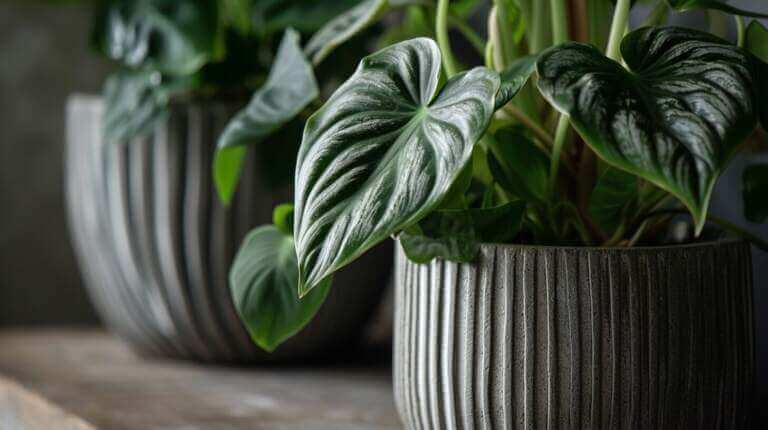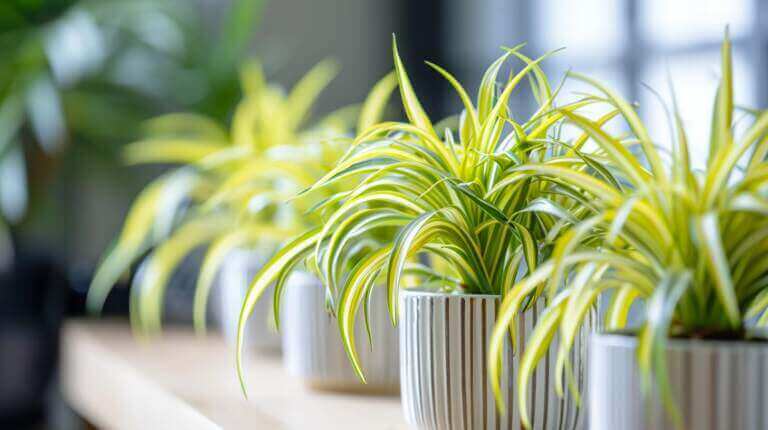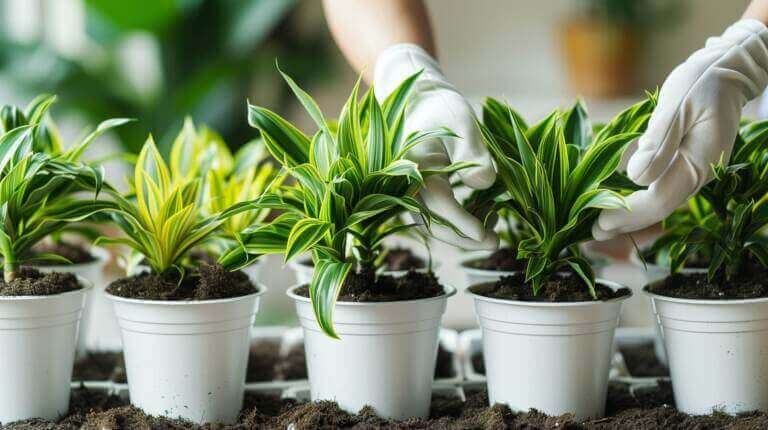Calathea Care Guide: Light, Water, and Humidity Requirements Explained
Calatheas are beautiful houseplants known for their unique foliage patterns and leaf movements. In this comprehensive guide, we will explore the light, water, and humidity needs of Calathea plants. By understanding these requirements, you can create the perfect environment for your Calathea to thrive and flourish.
Key Takeaways:
- Calatheas require indirect, moderate to bright light conditions.
- Water them regularly, keeping the soil moist but not soggy.
- Boost the humidity around your Calathea through methods like using a humidity tray or misting the leaves.
- Adjust your care routine based on the changing seasons.
- Repot your Calathea every one to two years using a well-draining potting mix.
Calatheas are stunning indoor plants that require specific care to thrive. By providing them with the right amount of light, water, and humidity, you can enjoy their beauty and foliage patterns in your home. Let’s dive deeper into the care requirements for these remarkable houseplants.
Light Conditions for Calathea Plants
When it comes to light requirements, Calathea plants thrive in indirect light conditions. They prefer being placed close to a north or east-facing window, where they can receive filtered or dappled sunlight throughout the day. It is important to avoid exposing them to direct sunlight, as it can scorch their delicate leaves. Some Calathea varieties can tolerate lower light levels, but for optimal growth and vibrant foliage, it is best to provide them with brighter light.
If your Calathea plant isn’t receiving enough natural light, you can supplement it with artificial grow lights. These lights should mimic the intensity and spectrum of natural light to ensure the plant’s overall health. When using artificial lights, it is essential to place them at an appropriate distance from the plant to prevent heat burn or light stress.
Light Requirements for Calathea Plants
| Light Level | Description |
|---|---|
| Indirect Light | Filtered or dappled sunlight throughout the day |
| Bright Light | Close to a north or east-facing window, with filtered sunlight |
| Low Light | Tolerated by some Calathea varieties, but not ideal for optimal growth |
| Medium Light Plants | Thrives in moderate to bright indirect light |
| Artificial Light | Supplement with grow lights if natural light is insufficient |
Watering Guidelines for Calathea Plants
Proper watering is essential for the health and vitality of Calathea plants. Understanding the watering needs and frequency is crucial to prevent overwatering or underwatering, both of which can be detrimental to the plant’s well-being. In this section, I will provide you with guidelines on how to water your Calathea effectively.
Watering Frequency:
The frequency of watering your Calathea will depend on various factors such as temperature, humidity, and the season. As a general rule, water your Calathea when the top inch of the soil feels dry to the touch. Avoid letting the soil completely dry out as it can cause stress to the plant, but also refrain from keeping the soil excessively wet as it can lead to root rot.
During the active growing season in spring and summer, you may need to water your Calathea more frequently due to higher evaporation rates. Monitor the soil moisture regularly and adjust the watering schedule accordingly. In contrast, during the cooler months of autumn and winter, the plant’s growth slows down, and the soil takes longer to dry out. Reduce the frequency of watering to prevent waterlogged soil.
Soil Moisture and Watering Technique:
It is important to maintain consistent moisture in the soil without overwatering. When watering your Calathea, use room temperature, filtered water to prevent mineral buildup. Take care not to use water that is too cold or chlorinated, as it can shock the roots and cause stress to the plant.
When watering, pour enough water into the pot until it starts to drain from the bottom. This ensures that the entire root ball is evenly moistened. Do not allow the pot to sit in standing water, as it can lead to root rot. If there is excess water in the saucer or tray, empty it to prevent waterlogging.
Signs of Underwatering and Overwatering:
Understanding the signs of underwatering and overwatering can help you adjust your watering routine and prevent potential problems. Signs of underwatering include wilting, dry and crispy leaves, and yellowing or browning of the foliage. On the other hand, overwatering can result in yellowing or drooping leaves, root rot, and the presence of fungus gnats. It is important to find a balance and provide your Calathea with consistent but not excessive moisture.
| Signs of Underwatering | Signs of Overwatering |
|---|---|
| – Wilting | – Yellowing or drooping leaves |
| – Dry and crispy leaves | – Root rot |
| – Yellowing or browning of foliage | – Presence of fungus gnats |
Humidity Requirements for Calathea Plants
Calathea plants thrive in environments with high humidity, mimicking the tropical conditions of their natural habitat. While they can tolerate regular household humidity levels, providing higher humidity can help them flourish and prevent leaf damage. Here are some key points to consider when it comes to humidity requirements for Calathea plants:
High Humidity
Calatheas appreciate high humidity levels, ideally ranging from 60% to 70%. This can be achieved by creating a microclimate around the plant that retains moisture in the air. One effective method is to use a humidity tray: place the plant on a tray filled with water and pebbles, ensuring that the water level is below the surface of the pebbles. As the water evaporates, it will increase the humidity around the plant. Another option is to use a room humidifier to maintain optimal humidity levels.
Low Humidity
If the humidity in your home is low, you can take steps to increase it for your Calathea plant. One simple method is to mist the leaves regularly with room temperature water. This creates a temporary increase in humidity around the plant. However, be cautious not to over-mist the leaves, as excessive moisture can lead to fungal diseases.
Humidity Troubleshooting
If you notice that the edges of your Calathea’s leaves are turning brown or crispy, it may be a sign of low humidity. Increase humidity by misting the leaves or using a humidifier. Alternatively, you can group your Calathea plants together or place them near other houseplants to create a more humid microclimate.
| Methods to Increase Humidity for Calathea Plants: |
|---|
| Use a humidity tray filled with water and pebbles. |
| Mist the leaves regularly with room temperature water. |
| Use a room humidifier to maintain optimal humidity levels. |
| Group Calathea plants together to create a more humid microclimate. |
By understanding and meeting the humidity needs of your Calathea plants, you can provide them with an environment that promotes healthy growth and vibrant foliage.
Seasonal Care for Calathea Plants
Proper care for Calathea plants varies depending on the season. Understanding the specific needs of your plant during different times of the year will help ensure its health and vitality. Here are some important guidelines for caring for your Calathea during spring and summer, as well as autumn and winter.
Caring for Calathea in Spring and Summer
In the warmer months, Calathea plants experience increased growth and require more frequent watering. Monitor the moisture levels in the soil and adjust your watering schedule accordingly. It’s important to keep the soil consistently moist but not overly saturated. You can use your fingers to test the soil’s moisture level; if it feels dry to a depth of 1-2 inches, it’s time to water your plant.
Additionally, Calathea plants benefit from higher humidity levels during spring and summer. Increase humidity by misting the leaves regularly or placing a humidity tray filled with water near the plant. This will help replicate the ideal tropical environment that Calatheas thrive in.
Caring for Calathea in Autumn and Winter
As the temperatures drop in autumn and winter, Calathea plants enter a period of dormancy. During this time, their growth slows down, and their water needs decrease. It’s important to reduce the frequency of watering and allow the top third of the soil to dry out before watering again.
During the colder months, it’s also crucial to protect your Calathea from cold drafts and keep it away from heat sources such as radiators or fireplaces. These temperature extremes can cause stress and damage the plant. Maintaining a stable temperature between 60°F and 75°F (15°C to 24°C) will help keep your Calathea healthy.
Repotting and Soil for Calathea Plants
Proper repotting and the right soil are essential for the health and growth of your Calathea plants. Repotting should be done every one to two years or when the plant outgrows its current container. This allows the plant to have enough space for its root system to expand and absorb nutrients efficiently.
When repotting your Calathea, choose a pot that is one size larger than its current one. This allows room for the roots to grow without drowning the plant in excess soil. It’s important to select a well-draining potting mix that promotes good airflow and prevents waterlogging, which can lead to root rot.
A suitable potting mix for Calathea plants should have a balanced blend of organic matter, such as peat moss or coconut coir, and perlite or vermiculite to improve drainage. The organic components retain moisture while allowing excess water to flow through, preventing waterlogged conditions. This ensures that the roots stay healthy and rot-free.
When to Repot Calathea Plants
The ideal time to repot your Calathea is during the spring or summer months when the plant is in its active growth phase. Signs that your Calathea may need repotting include roots growing out of the drainage holes, the plant drying out quickly between waterings, or the pot becoming too small to accommodate the root system.
When repotting, gently loosen the roots from the old soil and place the plant in the new pot, ensuring that the roots are covered with fresh potting mix. Press the soil gently around the roots to secure them in place. Avoid compacting the soil too tightly, as it can hinder proper drainage and airflow.
Remember to water your repotted Calathea thoroughly to help settle the soil and provide hydration to the plant. Place the repotted Calathea in a location that provides the appropriate light conditions and maintain regular care to ensure its successful transition into the new pot.
Maintenance Tips for Calathea Plants
Proper maintenance is essential for keeping your Calathea plants healthy and vibrant. By following these tips, you can ensure that your plants stay in optimal condition.
- Leaf Cleaning: Dust tends to accumulate on the large leaves of Calathea plants, affecting their appearance and ability to photosynthesize effectively. To keep them looking their best, gently wipe the leaves with a damp cloth or use a soft brush to remove the dust. Regular cleaning will help your plants thrive.
- Pruning: Pruning is important for maintaining the aesthetics of your Calathea plants and allowing for better airflow. Remove any dead or brown leaves to encourage the growth of new, healthy foliage. Pruning also makes it easier to monitor the overall health of the plant and identify any potential issues.
- Fertilization: Calathea plants benefit from regular fertilization during the growing season. Use a balanced, water-soluble houseplant fertilizer and follow the instructions on the packaging for the correct dosage. Avoid overfertilization, as it can lead to salt buildup in the soil, which can be detrimental to the plant’s health.
- Leaf Movements: One of the fascinating aspects of Calathea plants is their unique leaf movements. These plants exhibit nyctinasty, which means their leaves open and close in response to changes in light and darkness. This natural phenomenon adds to the charm of Calathea plants and showcases their adaptability.
Caring for Calathea Plants: A Quick Summary
| Aspect | Tip |
|---|---|
| Leaf Cleaning | Wipe gently with a damp cloth or use a soft brush to remove dust. |
| Pruning | Remove dead or brown leaves to maintain plant aesthetics and airflow. |
| Fertilization | Fertilize regularly during the growing season with a balanced, water-soluble houseplant fertilizer. |
| Leaf Movements | Observe and enjoy the unique opening and closing of the leaves in response to light and darkness. |
Popular Calathea Varieties
When it comes to the Calathea family, there are several popular varieties that stand out for their stunning foliage patterns. One such variety is the Calathea Mayokana, which is known for its exquisite peacock feather-like leaf patterns. The deep green leaves with striking markings make this variety a captivating addition to any indoor plant collection.
Another eye-catching variety is the Calathea Rufibarba, with its vibrant green leaves and burgundy undersides. This variety adds a touch of elegance to any space and is sure to draw attention with its unique color combination. If you’re looking for a plant with a bit of drama, the Calathea Rufibarba is an excellent choice.
For those who appreciate long, wavy leaves with distinctive markings, the Calathea Lancifolia is a great option. This variety features dark green leaves with purple markings that give it a striking appearance. The Calathea Lancifolia adds a touch of sophistication to any room and is sure to be a conversation starter.
Last but not least, the Calathea Musaica is a true work of art. This variety boasts intricately painted-like leaves that resemble a mosaic. With its unique leaf patterns and vibrant colors, the Calathea Musaica adds a touch of creative flair to any space. If you’re looking for a plant that is both visually stunning and easy to care for, the Calathea Musaica is an excellent choice.







